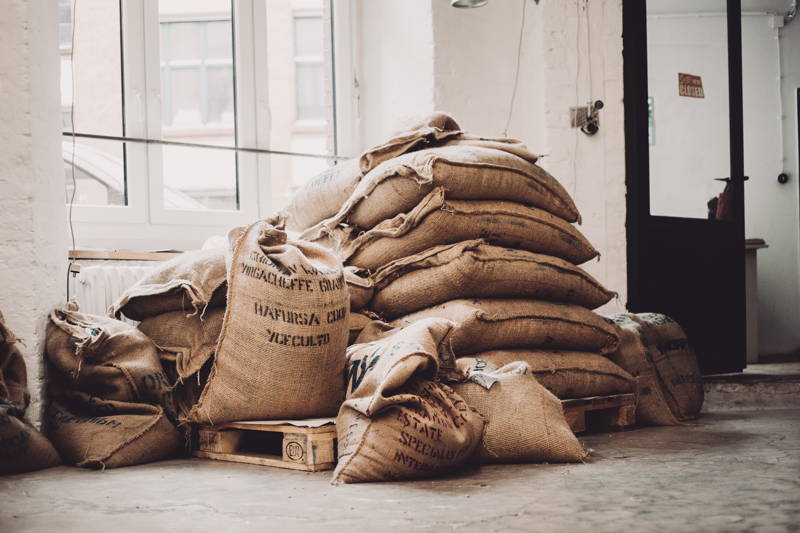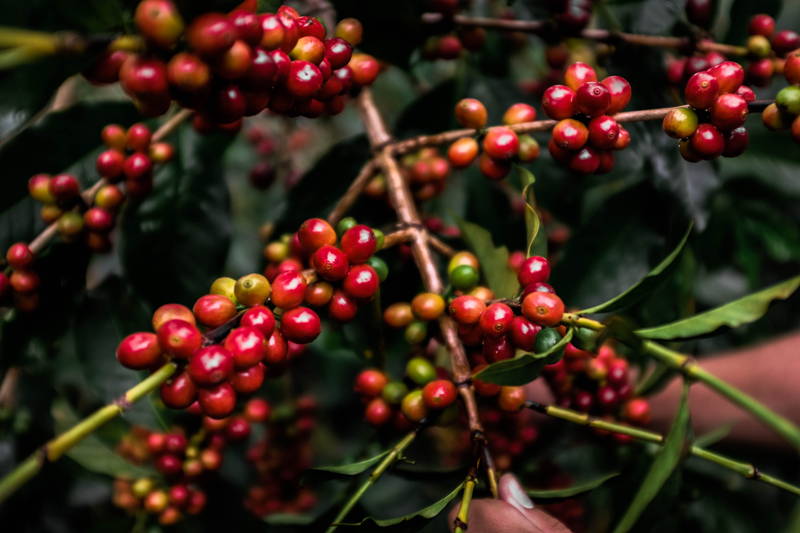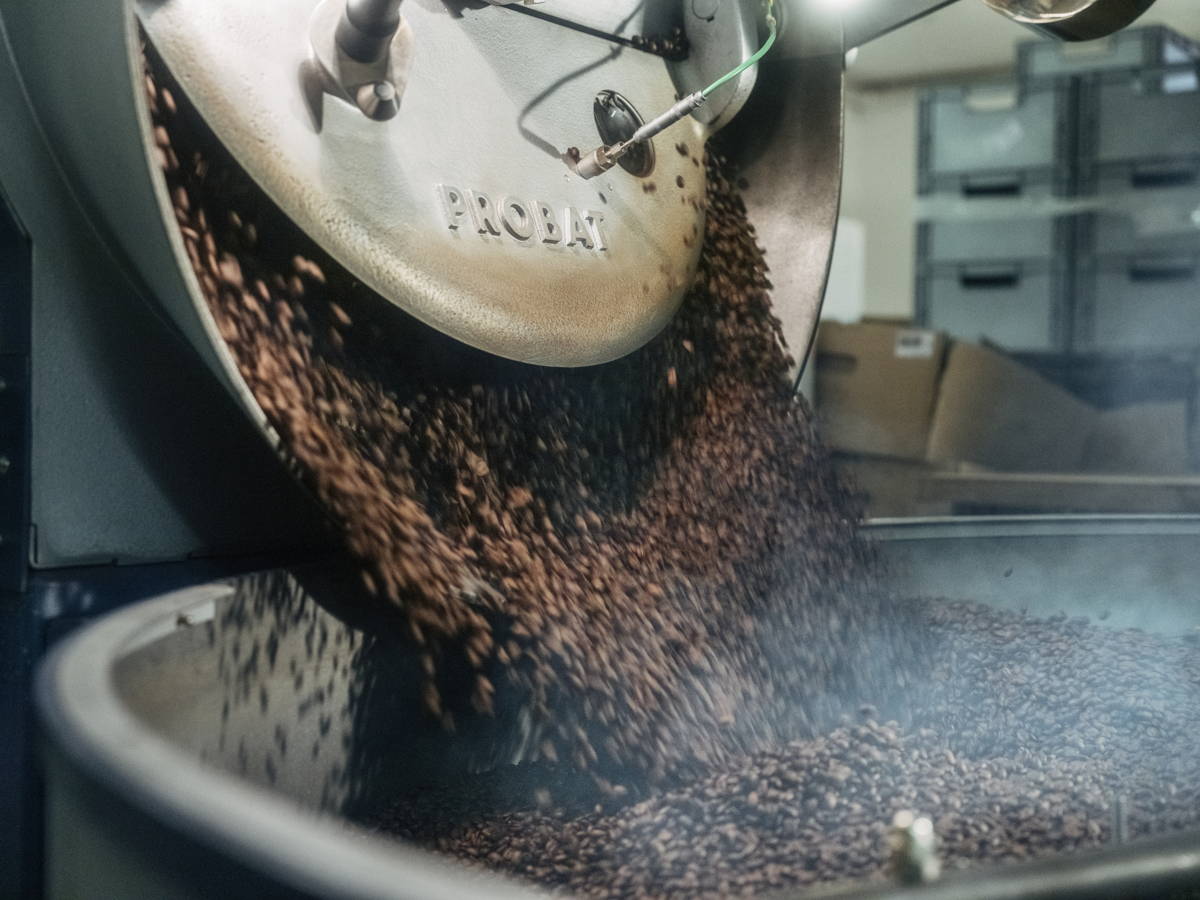

Ein Beitrag von Hannes Fendrich in der Kategorie #Kaffeewissen vom 27. März 2019
Obwohl die Specialty Coffee Industrie in den vergangenen Jahrzehnten immer stärker gewachsen ist, liegt der Fokus zu 98 % auf Arabica Kaffee. Die Pflanzengattung Coffea Canephora und deren bekannteste Varietät Robusta wird auch im Zuge der “Third Wave Bewegung” immer noch stark vernachlässigt. Auch für uns hat Robusta lange keine große Rolle gespielt, da wir der allgemeinen Ansicht gefolgt sind, Robusta sei weniger komplex, bitterer und im Geschmack “langweiliger” als Arabica. Erst als wir uns, dank unseren Freunden von JingJhai aus Laos, intensiver mit Robusta auseinandergesetzt haben, hat sich unser Bild von Robusta grundlegend geändert.
Es kursieren viele Vorurteile gegenüber Robusta in der Kaffeewelt – Eins davon ist, dass die Bohnen eine schlechte Qualität aufweisen. Arabica und Robusta Kaffee unterscheiden sich in vielen Aspekten. Zwei wesentliche sind, dass Robusta weniger Chromosome und mehr Chlorogensäure enthält als Arabica. Das macht diesen Kaffee im Geschmack weniger komplex und nicht so bekömmlich wie Arabica. Doch der größte Unterschied liegt eigentlich im Ursprung, denn dort floss bisher wenig Arbeit in die Steigerung der Kaffeequalität von Robusta Pflanzen.
Der Weg zum Qualitätsrobusta ist noch längst nicht abgeschlossen
Wir drehen uns im Kreis: Da der Ruf von Robusta schlecht ist, sind Konsument:innen nicht bereit einen hohen Preis für Robusta Kaffee zu zahlen, sodass Produzent:innen weltweit keinen Anreiz haben ihre Qualität zu steigern. Hinzu kommt, dass der Weltmarktpreis für Robusta noch geringer im Vergleich zu Arabica Kaffee ist. So wagt sich kaum ein Robusta-Produzierender das Risiko einzugehen höhere Produktionskosten für Robusta Kaffee zu bezahlen. Das Risiko diesen Kaffee nicht gewinnbringend zu verkaufen ist leider zu hoch. So steckt Robusta Kaffee in einer Art Qualitätsfalle. Erst allmählich schaffen es erste Produzent:innen dagegen zu steuern.
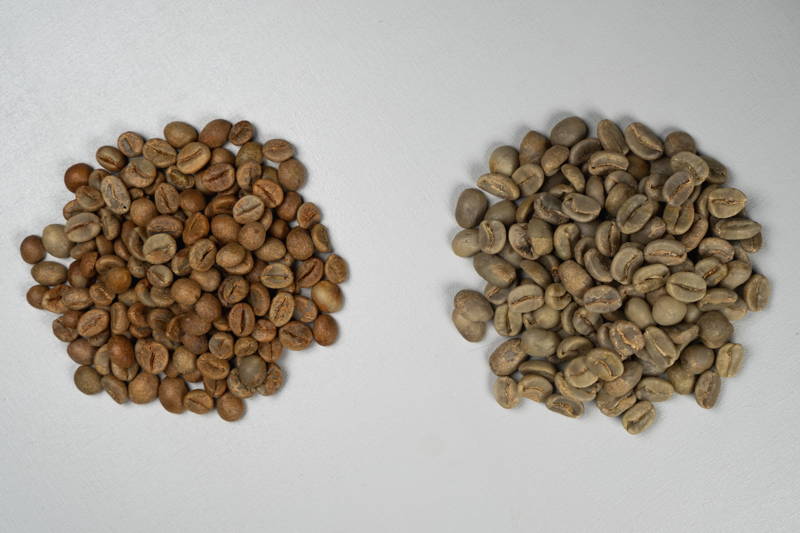
Foto: Robusta Bohnen (links) und Arabica Bohnen (rechts) im Vergleich
Glücklicherweise ist der Qualitätsgedanke bei Robusta inzwischen im Wandel.
Nachdem das Verbessern der Arabica Kaffees schon seit ca. 20 Jahren durch zahlreiche NGO Initiativen, Wettbewerbe wie den Cup of Excellence und das qGrader System des Coffee Quality Institute incentiviert wurde, steckt die Spezialitäten-Robusta-Industrie noch in den Kinderschuhen. Und das obwohl Robusta inzwischen einen Anteil am globalen Kaffeekonsum von ca. 40 % erreicht hat. Erst vor wenigen Jahren wurde das Robusta Pendant zu Spezialitäten Arabica Kaffee eingeführt, der sogenannte Ausdruck Fine Robusta. Von dem Uganda Coffee Development Authority und dem Coffee Quality Institute wurde ein offizieller Robusta Bewertungsbogen eingeführt und erst seitdem können Kaffeeprofis den Titel des “rGraders” erwerben, welches das Robusta Pendant zum qGrader für Arabica Kaffee ist (Scoresheet siehe hier).
Entdecke mehr dazu auf YouTube:
3 Gründe, warum Fine Robusta so spannend ist:
- Fine Robusta hinkt dem Spezialitäten-Arabica in der Entwicklung einige Jahrzehnte hinterher. Die Qualitätssprünge, die Fine Robusta in den nächsten Jahren machen kann, sind immens, da er gerade in der Aufbereitung und Verarbeitung der Kirschen nur wenig Sorgfalt und Aufmerksamkeit erhielt.
- Der genetische Pool, der bei Canephora zugrunde liegt, wurde noch nicht richtig erforscht. Dort ist noch einiges an Potenzial zur Qualitätsverbesserung verborgen.
- Generell kommt Robusta im Hinblick auf den Klimawandel eine große Bedeutung für die Zukunft zu, da immer mehr Anbauregionen weniger gut für den Anbau von Arabica geeignet sind. Denn Robustapflanzen sind robuster und resistenter, als ihre Verwandten Arabicapflanzen. Starke Sonneneinstrahlung, Temperaturschwankungen oder Insekten können Robusta kaum etwas anhaben. Es bietet den Kaffeefarmer:innen Chancen auch in Zukunft im Kaffeeanbau zu bleiben und ihre Einkommen zu steigern.
Wer tiefer in die Welt des Fine Robustas einsteigen will, dem empfehlen wir diese Podcasts:
Geschmacklich sollte Robusta nicht mit der Erwartungshaltung von Arabica Kaffee betrachtet werden. Robusta wird keine so komplexe Aromatik wie Arabica aufweisen können. Dennoch muss Robusta nicht nur nach Tabak und Gummi schmecken, sondern kann auch karamellige, nussige und würzige Noten mit sich bringen. Besonders beeindruckend ist für der volle und cremige Körper, den Robusta generiert und an dem sich kaum ein Arabica Kaffee messen kann.
Wir haben unsere Partner:innen in den Kaffeeanbauregionen zu unseren zwei Robusta Sorten befragt. Es ging darum mehr über die Umstände des Robusta Anbaus zu erfahren und herauszufinden, ob die Klischees, z. B. Robusta hat eine höhere Produktivität als Arabica und ist resistenter, tatsächlich zutreffen.
Interview in Laos
Is Robusta more productive than Arabica and how much more?
Michael: Technically, yes, Robusta is more productive per hectare than Arabica. You can get 3-5 tons of green beans per hectare. However, due to the low price of Robusta, the economics work out similar to that of Arabica. So even though it’s more productive, the increased labor costs, input costs, pest/disease, low price costs make it similar to the net revenue of Arabica.
Is Robusta more resistant than the Arabica trees?
Michael: It is to coffee rust, but not when it comes to drought. Plus there are other pests that plague Robusta (i.e. stem borer) that are not as common up in the highlands.
What is „more sustainable“ for the farmers – Arabica or Robusta?
Michael: „Sustainable“ is a huge, relative term. We can break it down to social, economic, environmental sustainability.
Technically, even selling the best Arabicas and Robustas are not enough income for a family to thrive. It’s usually enough to survive. Most farmers do not have enough land, therefore not enough capacity to produce enough coffee to have enough net sales to have enough income to really grow. Think about if you earn 7,000 USD per year for a family of 6, owning 1.2 hectares of land (80 % of coffee farmers have less than 2 hectares). About 2,000 USD goes to growing and harvesting. You’re left with 5,000 USD for your family. Now if you want healthcare? College? Bigger house? Etc. 500 USD a month is enough to survive, but not thrive.
Regardless of Arabica or Robusta, there is a dire need to diversify the crops. Coffee is only harvested one time (maybe two) times a year. That creates a one-time payment per year. This creates a cash-flow crisis for families. Diversifying allows for cash to be spread out over the year. Diversifying also increases income.
What do you think about the future? With regards to climate change will Robusta play even a bigger role for the farmers?
Michael: Genetics will play a role and protect Arabicas for the time being. Yes, I foresee more Robusta. People have zero clue about the potential of Robusta. It has been almost exclusively bred for quantity and cup quality be damned. Arabica, on the other hand, has been bred for quality. We have no clue what a well bred Robusta could taste like. It may be that the best Robustas could be better than the best Arabicas. We just do not know.
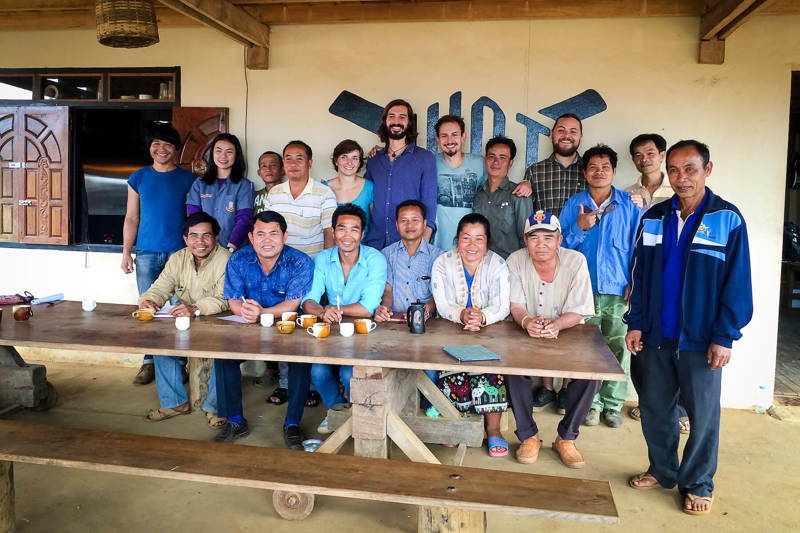
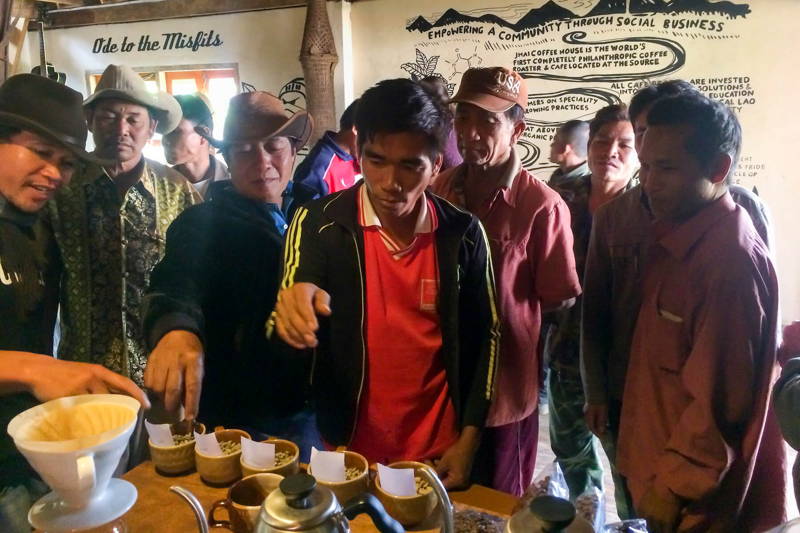
Interview in Indonesia
Is Robusta more productive than Arabica and how much more?
Lennart: So yes, ASNIKOM cooperative produces both Arabica and Robusta. Robusta is far more productive in terms of cherry output (30 %) and is indeed more resistant to climate shocks / rising temperatures – and hardly requires any care apart from pruning. The trees are tall and form a natural canopy over each other, creating a stable microclimate inside the fields as well. The ground is covered with natural nitrogen fixing plants and mulch, and no fertilization is therefore required. With Arabica, annual pruning and fertilization are necessary, and it can only be planted in (scarce) high elevations.
What is „more sustainable“ for the farmers you would say, Arabica or Robusta?
Lennart: In terms of post-harvest, we require the farmers to put in as much work as with Arabica, (which they weren’t used to) however. Because we pay a high premium, this has been successful, but in total Arabica still yields a slightly higher price. Farmers are slowly realizing though, that planting more robusta in lower areas makes sense because of this project, and because this is the third year we commit to more and more coffee, they are starting to trust this specialty Robusta „thing“ as a viable means of income. I don’t think there is an alternative for us other than to just buy the coffee year after year and show commitment this way. Cultural shifts in poor areas, when it comes to extra and different labor, only works if people can reliably expect payment.
What do you think about the future? With regards to climate change will Robusta play even a bigger role for the farmers?
Lennart: As for climate resilience, this is one of the main reasons for us to embark on this project. Arabica in most of Indonesia will become a huge problem in the next 20 years according to experts, and „fine Robustas“ are so far not hailed here as a solution as they are in India or Thailand, but we hope to change that. At least we see demand rising a lot here, which is a great thing to show the skeptics… 😉
Auch interessant:
Robusta vs Arabica – Wir zeigen dir die Unterschiede
Wo der Kaffee wächst: Die Top 10 Kaffeeanbauländer
Kaffee richtig dosieren – Wir zeigen dir das ideale Verhältnis von Kaffee zu Wasser

Hannes Fendrich
Hannes hat schon zu Studienzeiten in der heimischen WG-Küche damit begonnen, Kaffee zu rösten und ist nicht nur deshalb unser Mann! Hannes ist maßgeblich für die Auswahl, den Einkauf und die Röstung unserer Kaffees verantwortlich. Am liebsten trinkt er Filterkaffee - "black as midnight on a cloudless night".


